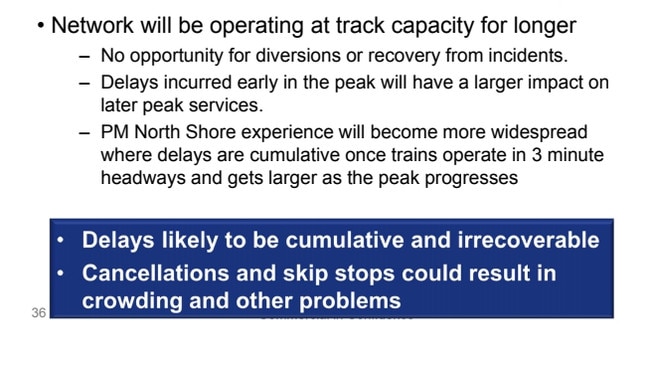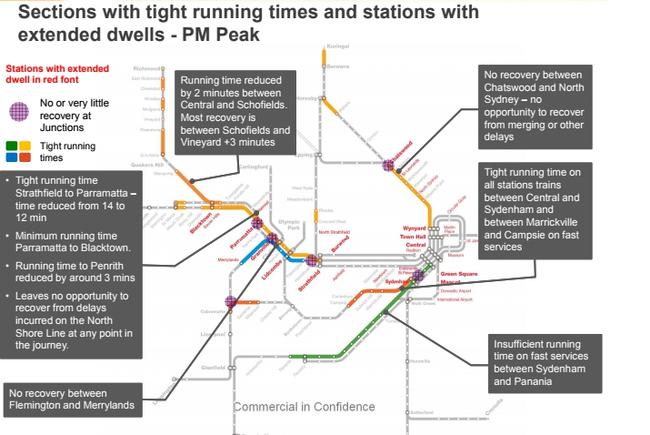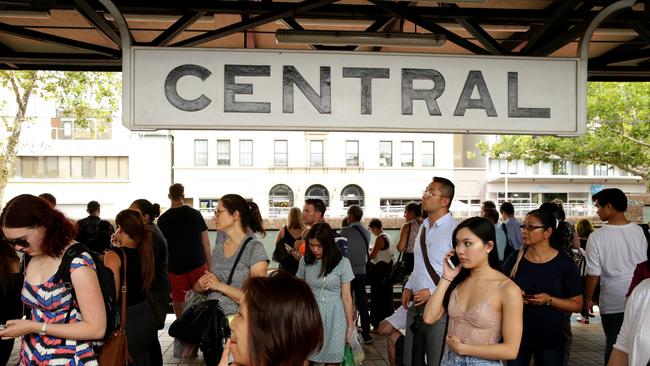Be it an “act of God” or a bungling bureaucracy, the commuter chaos in Sydney this week was a political train wreck for the Berejiklian government.
Seventy train drivers called in sick as storms took out substations and signalling on Tuesday, plunging public transport into mayhem across Australia’s biggest metropolis at peak hour.
Opposition leader Luke Foley was caught in the crush at Town Hall station on Tuesday evening, as fuming travellers waited for up to an hour to board a train home in sweltering heat.
We have never done this sort of industrial espionage, that’s not our game.
“You had railway staff trying to physically hold back people from going down the stairs because of the crush on the platform, but the numbers were building upstream so then the police were called in to deal with it,’’ Foley tells Saturday Extra.
“People were angry, they were hot, impatient — they were scenes reminiscent of a Third World city.’’

The chaos has ignited a blame game between the government and the train drivers’ union, which suspects the Coalition is planning to privatise Sydney Trains in the wake of its successful “franchising’’ of Sydney Ferries.
Transport Minister Andrew Constance is blaming wild weather and sick drivers for a debacle he describes as “an act of God’’. He has insinuated that train drivers are throwing sickies to sabotage the system in a push for a 24 per cent pay rise over the next four years.
While drivers voted yesterday to strike if they didn’t get their way, Rail Tram and Bus Union state secretary Alex Claassens insists there has been “no covert industrial action’’.
“If the system can’t handle an extra 10 workers being sick on any given day, then there’s something badly wrong,’’ he tells Saturday Extra.
Claassens told Radio 2GB on Wednesday “we have never done this sort of industrial espionage, that’s not our game. We’ve been warning people this was going to happen.
“We were not ready to take on this new responsibility of this new timetable … but the minister and the bureaucrats insisted this timetable had to start and we’ve been dealing with the mess ever since.’’

Sydney Trains was well aware of the potential pitfalls of introducing more than 1500 extra weekly train services in an ambitious new timetable last November. “Delays likely to be cumulative and irrecoverable,’’ a leaked critique, written by Sydney Trains network operations deputy executive director Michael Croning, warned.
“Cancellations and skip stops could result in crowding and other problems.’’
The internal document outlined a litany of likely problems — from “tight running times’’ along the Western and Northern lines to increased manual workloads for signalling, raising the risk of human error, and impossibly short stopping times at stations. The new timetable gives trains just 30 seconds to stop at a platform — including 20 seconds to get passengers off and on.
“Network will be operating at track capacity for longer,’’ the document states.
“No opportunity for diversions or recovery from incidents. Delays incurred early in the peak (travel time) will have a larger impact on later peak services.’’

On Tuesday, lightning strikes combined with driver shortages set off a domino effect of disruption. Despite ordering an inquiry into what went wrong, Constance insists the new timetable will stay — with “refinements’’.
“It’s the right thing to do, it’s the right timetable,’’ he says. “The main reason we put it in place is that over a 12-month period we had an 11 per cent increase in the number of customers catching trains. That is off the charts. A couple of bad days do not define the network.’’
Constance insists the failures flagged in the Sydney Trains document “happened every day on the network under the old timetable’’.
“With all lines leading to the City Circle, if you have an incident on one line it typically affects the entire network,’’ he says. “It’s not perfect by any stretch. But (on Tuesday) we had the perfect storm.’’

Foley blames poor planning for the train debacle.
“This was man-made. You can’t have a city of five million people where there are 30 train drivers off work and the train system goes into a complete meltdown,” he says.
“The Premier and the minister wanted to go out and boast they were delivering trains but no one did the fundamentals of ensuring there would be enough drivers for the trains before they hit ‘go’ on an ambitious timetable.’’
The chaos has thrown the spotlight on “Tube man’’ Howard Collins, the former London Metro boss who now earns a $695,000 salary as Sydney Trains chief executive. He is paid six times more than a typical train diver, who earns an average $113,000 a year, before tax, including overtime and allowances. Collins infuriated drivers by declaring most commuters would be “aghast’’ at their demand for a 6 per cent annual pay rise.

The minister is more conciliatory, praising Sydney Train’s 1170 drivers for their hard work and professionalism. He says a 24 per cent pay rise is out of the question, but is open to negotiating a compromise in return for efficiencies.
“The drivers, guards and station staff do an incredible job,’’ he says. “They have 12 months of training and are responsible for the safety of well over 1000 passengers on a fully laden train. The government is willing to give them a 2.5 per cent pay rise in line with the wage cap we have. If it is good enough for our nurses and teachers to be paid the wage cap, train drivers should have the same.’’
But he suggests there is a risk some drivers were “engaging in covert industrial action’’ by taking sick leave. On Tuesday, as technical problems plagued the system, 70 drivers called in sick — 30 more than at the same time last year.
“We’ve driver shortages because of an unexpected rise in sick leave. We’ve gone and employed 226 new drivers. But drivers can give two weeks’ notice that they’re leaving, yet take 12 months to train up,’’ Constance says.
Action for Public Transport secretary Jim Donovan says it is “crazy’’ that guards take a year to train.
New trains to be used on the Metro lines, still under construction, will operate without drivers or guards. The automated Metro service will be “franchised’’ but Constance insists there are “no plans’’ to privatise Sydney Trains too.
Professor David Hensher, founding director of the Institute of Transport and Logistics at Sydney University, says the train network is run down after 20 years of neglect.
“The Labor government spent more time developing plans but not implementing them,’’ he tells Saturday Extra.
“The real risk if we don’t sort this out soon is that people will go back to using cars.”


Teen boy dead, another loses arm in horror jet ski crash
A shocking jet ski accident has left a teenage boy dead and another in a critical condition with a severed arm.
Horror crash kills motorcyclist: M4 closed, rider hit twice
A critical incident probe is underway after a motorcyclist died in a crash on the M4 Motorway involving a sedan and a police car, forcing a closure of eastbound lanes and significant delays.